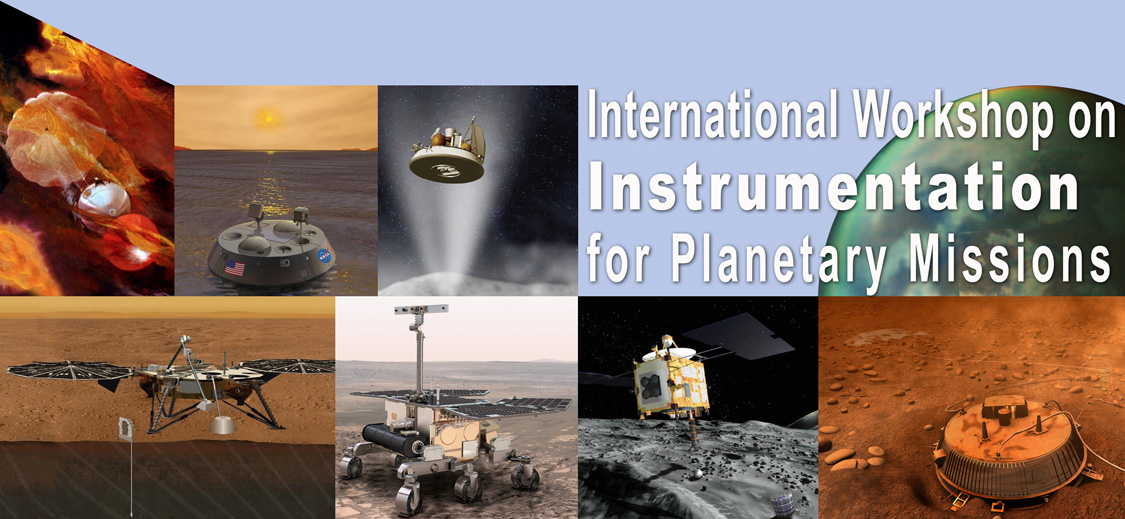Reviews of instruments on past missions (Sessions 1 and 2)
The Lunar Reconnaissance Orbiter: Instrumentation and Lessons Learned Vondrak R. R. , Keller J. W.
This presentation will focus on the Lunar Reconnaissance Orbiter (LRO) instruments and lessons learned from their development and operation.
We will also briefly describe significant results from the LRO mission.
MESSENGER - Heritage Orbital Gamma-Ray and Neutron Spectrometers Peplowski P. N.,
Goldsten J. O., Lawrence D. J., Evans L. G., Feldman W. C., Rhodes E. A.
The highly-successful MESSENGER Gamma-Ray and Neutron Spectrometer has applications to future planetary science missions.
Compact Imagers Based on MESSENGER's Mercury Dual Imaging System Chabot N. L.,
Murchie S. L., Hawkins S. E. III, Hayes J. R., Boldt J. D., Barnouin O. S., Heffernan K., Noble M. W.
MESSENGER's Mercury Dual Imaging System (MDIS) has acquired >130,000 images since launch in 2004, including the first images from Mercury
orbit. MDIS, composed of two miniature cameras, has capabilities well matched to future planetary missions.
The Titan Cassini-Huygens Probe Lebreton J.-P.
The Huygens probe mission achievements and instrument performances are reviewed. Lessons learned regarding Huygens probe system and instrument
operations are discussed in the context of the Huygens heritage for future in situ Titan missions.
The Phoenix Mars Lander West Chemistry Laboratory (WCL): Understanding the Aqueous Geochemistry of the Martian Soil
Kounaves, S.P.
The results of the Wet Chemistry Laboratory (WCL) on the 2007 Phoenix Mars lander have provided an unexpected view of the martian soils and their
aqueous geochemistry, identifying a variety of parameters, including ionic species, pH, and redox potential.
MECA Wet Chemistry: The Next Generation. Quinn R. C., Aubrey A. D., Hecht M. H., Grunthaner
F. J., Lee M. C., O'Neil G. D., DeFlores L.
The NERNST project is focused on developing the next generation wet chemistry laboratory based on techniques employed and lessons learned during
the Mars Phoenix Microscopy, Electrochemistry, and Conductivity Analyzer (MECA) in situ experiments.
Combined Raman and LIBS for Planetary Surface Exploration: Enhanced Science Return Enabled by Time-Resolved Laser Spectroscopy
Blacksberg J., Maruyama Y., Choukroun M., Charbon E., Rossman G. R.
We present a mineralogy tool that can potentially perform phase and elemental analysis on rock, soil, and regolith in an undisturbed geological setting. This is made
possible by new developments in the field of time-resolved laser spectroscopy.
Reducing Space-based Science Instrument Cost and Mass with a Modular Off-the-Shelf System
Ravine M.A., Schaffnet J.A., Caplinger M.A.
Malin Space Science Systems has developed a modular spaceflight imaging system for engineer purposes. In development are science-quality cameras, enabling
science imaging systems for modest mass and cost relative to custom designed instruments.
High-Performance Pushbroom Imagers for Planetary Exploration Bergstrom J. W. , Dissly R. W.
This paper summarizes the features of multiple pushbroom imagers, and describes technical trends that will enhance the capabilities of future imagers for planetary missions.
The Juno Mission Bolton S. J., Juno Team
Launched in August 2011, Juno arrives at Jupiter in 2016 for a one-year prime mission. This paper discusses the mission and the associated challenges
with developing the science instrumentation.
Saturn Atmospheric Structure Investigation: An Assessment of and Challenges and Recommendations for Extending the Galileo Approach to Future Probe Missions
Venkatapathy E., Ellerby D., Prabhu D., Martinez E.
This paper provides a review of the methodology developed and applied by Seiff et al. in constructing the upper atmospheric thermal structure of Jupiter's atmosphere from the
Galileo Probe entry data and the challenges in extending it to the Saturn Probe mission.
The Composite Infrared Spectrometer on Cassini: 15 Years in Flight Jennings D. E.,Kunde V. G., Flasar F. M.
The Composite Infrared Spectrometer (CIRS) on Cassini has been performing successfully since its launch in October, 1997. After fifteen years many features of CIRS are
still relevant for space-borne infrared spectrometers.
Long-Range Reconnaissance Imager on New Horizons
Cheng A. F.,Weaver H. A., Conard S. J., Hayes J. R., Morgan M. F., Noble M,. Taylor H. W., Barnouin O., Boldt J. D. ,Darlington E. H., Grey M. P. ,Magee T., Rossano E.,
Schlemm C., Kosakowski K. E., Sampath D.
LORRI is the highest resolution imager on the New Horizons (NH) mission to Pluto and the Kuiper belt. LORRI produced superb images of Jupiter and its
satellites even though those bodies are ~35 times brighter than bodies in the Pluto system.
Can (and Will) the Data be Processed? Technology Development to Address Science Questions
Archinal B.A., Kirk R.L., Keszthelyi L.P., Gaddis L.R., Rosiek, M.R.
Regarding the workshop theme of technology needed to address science questions, we summarize urgent issues regarding software, geodetic control, and
standardization, in order to process instrument data so as to obtain the greatest science return.



